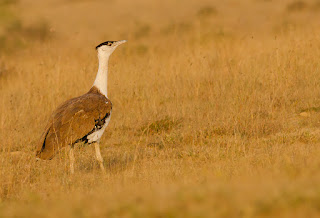Great Indian bustard
Key Facts
- Common Name: Great Indian bustard
- Scientific Name : Ardeotis nigriceps
- Population : 200 individuals worldwide
- Height : 100 cms or 1 metre
- Length : Wingspan of 210-250 cm
- Weight : 15-18 kg
Status : Listed in Schedule I of the Indian Wildlife (Protection)Act, 1972, in the CMS Convention and in Appendix I of CITES, as Critically Endangered on the IUCN Red List and the National Wildlife Action Plan (2002-2016). It has also been identified as one of the species for the recovery programme under the Integrated Development of Wildlife Habitats of the Ministry of Environment and Forests, Government of India.
Characteristics
The great Indian bustard can easily be distinguished by its black crown on the forehead contrasting with the pale neck and head. The body is brownish and the wings are marked with black, brown and grey. Males and females generally grow to the same height and weight but males have larger black crowns and a black band across the breast. They breed mostly during the monsoon season when females lay a single egg on open ground. Males have a gular pouch, which helps produce a resonant booming mating call to attract females and can be heard up to a distance of 500 metres. Males play no role in the incubation and care of the young, which remain with the mother till the next breeding season. These birds are opportunist eaters. Their diet ranges widely depending on the seasonal availability of food. They feed on grass seeds, insects like grasshoppers and beetles, and sometimes even small rodents and reptiles.
HABITAT AND DISTRIBUTION
Historically, the great Indian bustard was distributed throughout Western India, spanning 11 states, as well as parts of Pakistan. Its stronghold was once the Thar desert in the north-west and the Deccan plateau of the peninsula. Today, its population is confined mostly to Rajasthan and Gujarat. Small population occur in Maharashtra, Karnataka and Andhra Pradesh. Bustards generally favour flat open landscapes with minimal visual obstruction and disturbance, therefore adapt well in grasslands. In the non-breeding season they frequent wide agro-grass scrub landscapes. While in the breeding season (summers and monsoons) they congregate in traditional undisturbed grassland patches characterized by a mosaic of scantily grazed tall grass (below 50 cm). They avoid grasses taller than themselves and dense scrub like thickets.
Conservation Issues
The biggest threat to this species is hunting, which is still prevalent in Pakistan. This is followed by occasional poaching outside Protected Areas, collisions with high tension electric wires, fast moving vehicles and free-ranging dogs in villages. Other threats include habitat loss and alteration as a result of widespread agricultural expansion and mechanized farming, infrastructural development such as irrigation, roads, electric poles, as well as mining and industrialization.
WWF-India’s Initiatives
WWF-India has provided inputs in developing the ‘Guidelines for the State Action Plan for Resident Bustard Recovery Programme’. It has played an important role in raising awareness about the declining populations and highlighting the importance of implementing a focused bustard conservation programme at the national level. WWF-India, is undertaking initiatives towards conservation of GIB in and around Desert National Park. In near future, WWF also plans to expand the work in Gujarat and is making efforts to raise funds towards this.

Comments